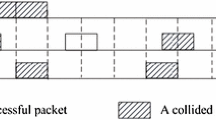Abstract
A conflict-avoiding code (CAC) C of length n and weight k is a collection of k-subsets of \({\mathbb{Z}}_n\) such that \(\Delta(x) \cap \Delta(y) = \emptyset\) holds for any \(x,y\in C\) , \(x\not= y\) , where \(\Delta(x)=\{j-i\,|\, i,j\in x, i\not= j\}\) . A CAC with maximum code size for given n and k is called optimal. Furthermore, an optimal CAC C is said to be tight equi-difference if \(\bigcup_{x\in C}\Delta(x)={\mathbb{Z}}_n\setminus \{0\}\) holds and any codeword \(x\in C\) has the form \(\{0,i,2i,\ldots,(k-1)i\}\) . The concept of a CAC is motivated from applications in multiple-access communication systems. In this paper, we give a necessary and sufficient condition to construct tight equi-difference CACs of weight k = 3 and characterize the code length n’s admitting the condition through a number theoretical approach.
Similar content being viewed by others
References
Berndt B.C., Evans R.J. (1979). Sums of Gauss, Jacobi, and Jacobsthal. J. Number Theory 11: 71–80
Buratti M. (1995). A powerful method for constructing difference families and optimal optical orthogonal codes. Des. Codes Cryptogr. 5(1): 13–25
Colbourn C.J., Dinitz J.H., Stinson D.R.: Surveys in combinatorics. In: Lamb, J.D., Preece, D.A., (eds.) pp. 37–100. Applications to communications, cryptography, and Networking. London Math. Soc. Lecture Note, ser. 267, Cambridge Univ. Press (1999).
Chung F.R.K., Salehi J., Wei V.K. (1989). Optical orthogonal codes: Design, analysis, and applications. IEEE Trans. Inform. Theory 35(3): 595–604
Chung H., Kumar P.V. (1990). Optical orthogonal codes—New bounds and an optimal construction. IEEE Trans. Inform. Theory 36: 866–873
Evans R.J. (1980). The 2r-th power character of 2. J. Reine Angew. Math. 315: 174–189
Evans R.J. (1981). Rational reciprocity laws. Acta Arith. 39: 281–294
Györfi L., Vajda I. (1993). Constructions of protocol sequences for multiple access collision channel without feedback. IEEE Trans. Inform. Theory 39(5): 1762–1765
Hasse H. (1975). Mathmatische Abhandlungen Band 1. Walter de Gruyter, Berlin, pp. 355–413.
Jimbo M., Mishima M., Janiszewski S., Teymorian A.Y., Tonchev V.: On conflict-avoiding codes of length n = 4m for three active users. IEEE Trans. Inform. Theory (to appear).
Levenshtein V.I.: Conflict-avoiding codes for three active users and cyclic triple systems. preprint.
Levenshtein V.I., Tonchev V.D.: Optimal conflict-avoiding codes for three active users. In: 2005 IEEE International Symposium on Information Theory, pp. 535–537, Adelaide, Australia, (2005).
Massey J.L., Mathys P. (1985). The collision channel without feedback. IEEE Trans. Inform. Theory 31(2): 192–204
Mathys P. (1990). A class of codes for a T active users out of N multiple-access. IEEE Trans. Inform. Theory 36(6): 1206–1219
Momihara K., Müller M., Satoh J., Jimbo M.: Constant weight conflict-avoiding codes. SIAM J. Discr. Math. (to appear).
Nguyen Q.A., Györfi L., Massey J.L. (1992). Constructions of binary constant weight cyclic codes and cyclically permutable codes. IEEE Trans. Inform. Theory 38(3): 940–949
Ribenboim P. (2001). Classical theory of algebraic numbers. Springer-Verlag, New York
Tsybakov B.S., Rubinov A.R. (2002). Some constructions of conflict-avoiding codes. Prob. Inf. Trans. 38(4): 268–279
Author information
Authors and Affiliations
Corresponding author
Additional information
Communicated by V.A. Zinoviev.
Rights and permissions
About this article
Cite this article
Momihara, K. Necessary and sufficient conditions for tight equi-difference conflict-avoiding codes of weight three. Des. Codes Cryptogr. 45, 379–390 (2007). https://doi.org/10.1007/s10623-007-9139-5
Received:
Revised:
Accepted:
Published:
Issue Date:
DOI: https://doi.org/10.1007/s10623-007-9139-5




